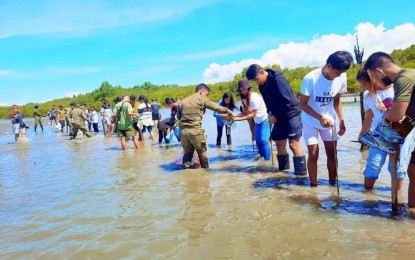
MANGROVE REFORESTATION. Volunteers plant 20,000 mangrove seedlings in mudflats at the boardwalk vicinity in Tanjay City, Negros Oriental on July 23, 2022. The Allied Mangrove Planting Organizations in Negros Oriental aims to reach its goal of planting 600,000 mangrove trees by October. (Photo courtesy of Sidney Lee)
DUMAGUETE CITY – An alliance of volunteer groups in Negros Oriental has committed to planting thousands of mangrove trees yearly and relentlessly to protect the province’s shorelines and support global efforts against climate change.
Sidney Lee, the planting coordinator of the Allied Mangrove Planting Organizations (AMPO), said in an interview on Tuesday that they target to plant 600,000 mangrove trees by October.
“We have already planted 520,000 mangrove trees since October 2015, and last July 23, we were able to plant an additional 20,000 mangrove seedlings at the boardwalk area in Tanjay City,” Lee said.
“The remaining 60,000 mangrove trees for our target this year can be easily accomplished by then, as there are plenty of volunteers willing to undertake the activity each month.”
He explained the need to raise awareness of the importance of mangroves, saying that not all people understand the role of these coastal trees or shrubs that provide not only shoreline protection but also food and shelter to animals.
"Mangroves are also a natural habitat for certain marine creatures and help in carbon sequestration that can result in reduced carbon footprint, no matter how small," Lee said. “They play a very important role in carbon sequestration, which do twice as much than terrestrial trees."
He said while mangroves are common in the Philippines, with 33 species growing throughout the archipelago, they are under threat because humans use these coastal trees for firewood.
The sea forest restoration effort in the province began in 2015 with the Negros Oriental ROTC (Reserve Officers’ Training Corps) Association of Corps Commanders (NORACC), of which Lee is a member, taking the lead to plant one million mangrove trees in 10 years.
The local government unit of Tanjay City in Negros Oriental back then agreed to allow the NORACC to rehabilitate and restore 52 hectares of mudflats around its boardwalk to be planted with mangrove trees.
“This is our primary site for the massive mangrove forest restoration, with the 540,000 trees and seedlings already planted,” Lee said.
The NORACC later spearheaded the informal coalition of AMPO, comprising 12 non-government organizations that have volunteered to join the advocacy to revive the declining mangrove forests in the Tanjay boardwalk, now a famous tourist destination.
He said in their early years, they planted 100,000 mangrove trees a year but the pandemic slowed down their efforts for about two years.
The boardwalk was locked down so the group had to find an alternative area in Banilad in this capital city, where they planted mangroves when the quarantine restrictions had already eased, Lee said.
“But our goal is to actually be able to plant one million mangrove trees at the boardwalk in 10 years, and we are optimistic that we can achieve that, many thanks to the volunteers from the government and non-government sectors, including the youth,” he added.
In the coming years, the alliance will go beyond the boardwalk mudflats to continue its advocacy for rejuvenating and planting more mangroves across the province.
Lee said as the world celebrates International Day for the Conservation of the Mangrove Ecosystem on July 26, the alliance is hopeful that more organizations and individual volunteers would be educated on the importance of the mangrove ecosystem and become actively involved in their protection and conservation. (PNA)
